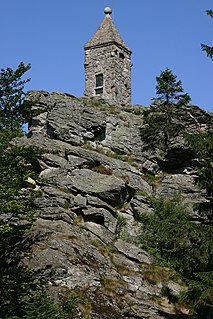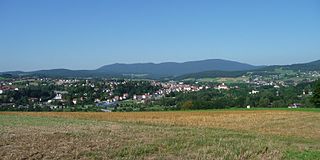
The Lamer Winkel is a region in the northern Bavarian Forest between the mountains of Hoher Bogen, Osser, Arber and Kaitersberg; politically it belongs to the county of Cham in the Bavarian province of Upper Palatinate.

The Lamer Winkel is a region in the northern Bavarian Forest between the mountains of Hoher Bogen, Osser, Arber and Kaitersberg; politically it belongs to the county of Cham in the Bavarian province of Upper Palatinate.
This formerly remote valley is one of the most scenic regions of the Bavarian Forest and, as a result, has been heavily developed in recent decades for tourism. In the Lamer Winkel are the municipalities of Lohberg, Lam and Arrach, which form a popular holiday region, especially for families.
The valley is surrounded by the densely wooded ridges of the Hoher Bogen and the Kunisch Mountains in the north and by the crests of the Arber and Kaitersberg in the south. There are numerous hiking trails to the surrounding summits as well as along the valley. Hiking, walking, cycling and, in winter, cross-country skiing are popular activities.
The Lamer Winkel is not only accessible by car, but also with the Oberpfalzbahn railway, which runs from Cham to Lam. The latter is the largest village in the valley and gives it its name. It remains an unspoilt market village.
The Lamer Winkel was first developed in 1279 by clearance and settlement activity under the aegis of Rott am Inn Abbey. By 1420 most of the villages outside Lam had been established. In the 15th century, the Hussite Wars and Böckler War led to considerable devastation and abandonment. In the 16th century the villages and farmsteads were rebuilt The old glassworks, glass grinding workshops and hammer mills in Lohberghütte and Schrenkenthal developed into early industrial sites in the 19th century.
Cham is a Landkreis (district) in Bavaria, Germany. It is bounded by the districts of Regen, Straubing-Bogen, Regensburg and Schwandorf and by the Czech Plzeň Region.

The Bavarian Forest is a wooded, low-mountain region in Bavaria, Germany that is about 100 kilometres long. It runs along the Czech border and is continued on the Czech side by the Bohemian Forest. Most of the Bavarian Forest lies within the province of Lower Bavaria, but the northern part lies within Upper Palatinate. In the south it reaches the border with Upper Austria.

The Rhön Mountains are a group of low mountains in central Germany, located around the border area where the states of Hesse, Bavaria and Thuringia come together. These mountains, which are at the extreme southeast end of the East Hesse Highlands, are partly a result of ancient volcanic activity. They are separated from the Vogelsberg Mountains by the river Fulda and its valley. The highest mountain in the Rhön is the Wasserkuppe, which is in Hesse. The Rhön Mountains are a popular tourist destination and walking area.

The Bohemian Forest, known in Czech as Šumava and in German as Böhmerwald, is a low mountain range in Central Europe. Geographically, the mountains extend from Plzeň Region and South Bohemia in the Czech Republic to Austria and Bavaria in Germany, and form the highest truncated uplands of the Bohemian Massif, up to 50 km wide. They create a natural border between the Czech Republic on one side and Germany and Austria on the other.

Rimbach is a municipality in the district of Cham (district) in the Upper Palatinate in Bavaria in Germany.

The Großer Arber ; Czech: Velký Javor, "Great Maple") or Great Arber, is the highest peak of the Bavarian/Bohemian Forest mountain range and in Lower Bavaria, with an elevation of 1,455.5 metres (4,775 ft). As a result, it is known in the Lower Bavarian county of Regen and the Upper Palatine county of Cham as the "King of the Bavarian Forest". Its summit region consists of paragneiss.

Altaussee is a municipality and spa town in the district of Liezen in Styria, Austria. The small village is nestled on the shores of the Lake Altaussee, beneath the Loser Plateau. Occupying an area of 92 km², Altaussee is home to 1,777 people. The municipality includes two cadastral communities: Altaussee and Lupitsch. The designated climatic spa is within the Salzkammergut region. Altaussee has the biggest salt deposits of Austria, which are still mined today.

The Kaitersberg is a low mountain crest up to 1,132 metres (3,714 ft) east of Bad Kötzting in the Bavarian Forest in southern Germany. Its long ridge runs eastwards towards the Großer Arber.

The Mittagstein is a 1,034-metre-high (3,392 ft) mountain peak which rises in the middle of the Kaitersberg in the Bavarian Forest in southern Germany.

The Kreuzfelsen is a 999 m (3,278 ft) high rock outcrop, that forms the western cornerstone of the Kaitersberg mountain ridge in the Bavarian Forest in southern Germany. From the giant cross on its summit the view sweeps down into the Zeller Valley and over to the town of Bad Kötzting and also far over the western part of the Bavarian Forest.
The Upper Palatine-Bavarian Forest, is a natural region in Germany in the northeast of Bavaria. It mainly comprises the low mountain ranges of the Bavarian Forest and Upper Palatine Forest which are up to 1456 m high and border on the Bohemian Massif immediately inside the Czech Republic's southwestern border with Germany.

The Kleiner Arber, sometimes also the Little Arber, in the Bavarian Forest is a mountain, 1,383.6 m above sea level (NHN), and the highest peak in the Bavarian province of Upper Palatinate. The border with Lower Bavaria runs over its summit and that of the Großer or Great Arber to the east. An elongated rock outcrop west of the summit cross is the actual highest point in the Upper Palatinate.

The Enzian is a mountain, 1,285 m above sea level (NHN), in the Bavarian Forest in Germany. It rises from the ridge northwest of the Arber and its summit lies on the boundary between the counties of Cham and Regen, with the municipality of Lohberg in the north and Drachselsried in the west-southwest.

The Hoher Göll is a 2,522 m (8,274 ft) mountain in the Berchtesgaden Alps. It is the highest peak of the Göll massif, which straddles the border between the German state of Bavaria and the Austrian state of Salzburg.

The Hohe Bogen is a roughly 8-kilometre-long mountain ridge in the Bavarian Forest.

The Ödriegel is an elongated ridge of the Arber ridge in the northern Bavarian Forest. On its flat summit, there are some fantastic vistas that offer a view of Lam, the Osser and the Hohenbogen. Most hikers will pass the Ödriegel on their tour along the European Walking Route E6, from the Arber to the Kaitersberg. It is hardly ever climbed as an independent mountain, but usually in connection with its neighbours, the Mühlriegel and Schwarzeck.

The Osser is a mountain on the border between Germany and the Czech Republic, in the Bavarian Forest and Bohemian Forest and which belongs to the Kunisch Mountains.

The Upper Bavarian Forest Nature Park covers an area of 1,796 km² and is thus one of the largest nature parks in the German state of Bavaria.

The Lallinger Winkel is a high valley, 162 km² in area, named after the village of Lalling, in the county of Deggendorf in the Bavarian Forest, Germany.